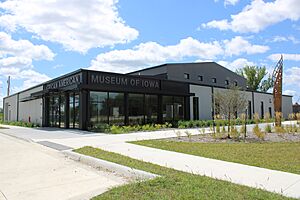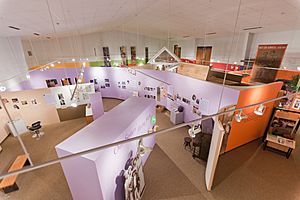African American Museum of Iowa facts for kids

African American Museum of Iowa
|
|
| Established | 1993 |
|---|---|
| Location | 55 12th Avenue SE, Cedar Rapids, Iowa 52401 |
| Type | African American heritage |
The African American Museum of Iowa (AAMI) is a special place in Cedar Rapids, Iowa. It sits right by the Cedar River. Its main goal is to teach everyone about the history and culture of African American people in Iowa.
The museum started in 1993. It is now the best place to learn about African American history in Iowa. The AAMI has a main exhibit called Endless Possibilities. It also has a new temporary exhibit each year. Plus, the museum has "traveling exhibits" that can visit schools and libraries.
Each year, over 30,000 people visit the AAMI. The museum offers tours and fun learning programs for all ages. It also hosts special events across the state of Iowa.
Contents
Museum History
How the Museum Started
The African American Museum began in 1993. A small group from a church in Cedar Rapids started it. They wanted to save the history of African Americans in Iowa. This was to celebrate Black History Month. That same year, a group called the African American Heritage Foundation, Inc. was officially formed.
In 1998, the foundation hired its first full-time leader. His name was Joseph McGill. In 2000, a temporary museum opened in a mall. Then, in April 2002, building began on a new, modern museum. It was 17,000 square feet and located by the Cedar River.
Grand Opening and New Exhibits
In May 2003, Thomas Moore became the museum's leader. The AAMI officially opened on September 19, 2003. It featured a main exhibit called Doorways: A History of African Americans in Iowa.
The next year, the museum created a special fund to help it grow. A new part of the main exhibit called Africa also opened. Visitors could learn about West Africa. They could imagine the difficult journey of the Middle Passage to the United States.

In 2005, a bridge near the museum was renamed the Dr. Martin Luther King Jr. Memorial Bridge. A public art piece called Trumpet was also placed on the museum grounds. It is near the Cedar River Trail.
Growing Across Iowa
In 2006, the museum started chapters in eight Iowa communities. This helped share history with more people. In 2007, the AAMI received a grant to help these chapters. They also got a grant for a statewide project. This project was called Adult Voices–Children’s Eyes: Iowa's African American Oral History Project. Young people learned to record important stories from their communities. This helped them discover a love for history.
Overcoming Challenges
In 2008, a big flood hit Iowa. The museum's first floor was filled with 5.5 feet of water. This caused a lot of damage to the building. About half of the museum's historical items were also damaged. Repairs cost $1.3 million.
The AAMI reopened on January 17, 2009. It had new repairs and a new temporary exhibit. This exhibit was about a town called Buxton. On December 15, 2009, a new main exhibit opened. It was called Endless Possibilities. It uses photos, objects, and stories to show the journeys of African Americans in Iowa.
Recent Renovations
In spring 2023, the AAMI started a big renovation project. This $5 million project was needed because of updates to Cedar Rapids' flood control system. The museum used this chance to make other important changes inside and outside. The museum also worked to raise more money for its future.
The museum reopened to the public in May 2024. The Trumpet art piece was moved near the museum's new entrance.
Collections and Exhibits
The AAMI has a large collection of items. It includes over 2,000 historical objects. There are also 70 feet of old documents and 200 recorded oral histories. The museum's library has over 1,000 books about African and African American topics.
Museum Galleries
The AAMI has two main exhibit areas. One area holds Endless Possibilities. This main exhibit was put in place in 2009. It shows the history of African Americans in Iowa. It covers their journey from Western Africa, through slavery, the American Civil War, and the Underground Railroad. It also shows the Civil Rights Movement and achievements today.
The second exhibit area is the Gale Sayers Changing Exhibit Gallery. This gallery shows at least one new temporary exhibit each year.
Some past exhibits have included:
- Exhibits about challenging topics (2024-2025)
- 30 Years of the AAMI (2024)
- Power and Impact (2023-2024)
- Suspended: Systemic Oppression in Our Schools (2022-2023)
- Mapping Exclusion: Redlining in Iowa (2021-2022)
- Unwavering: 21st Century Activism (2020-2021)
- Untangling the Roots (2019-2020)
- Driven By Hope (2018-2019)
- If Objects Could Talk (2017-2018)
- Mightier Than the Sword (2016-2017)
- Products of a Creative Mind (2015–2016)
- Behind the Beat (2014–2015)
- Western Africa: Before the Boats (2013–2014)
- The Only One (2012)
Traveling Exhibits
The AAMI also has exhibits that can travel to other places. These exhibits can be reserved by schools and other groups.
Some of these traveling exhibits are:
- Behind the Beat
- Driven By Hope
- Iowa Civil Rights
- Iowa Roots, Global Impact: The Life and Legacy of George Washington Carver
- Mapping Exclusion: Redlining in Iowa
- No Roads Lead to Buxton
- The Only One
- Products of a Creative Mind
- Riding the Freedom Train: The Underground Railroad in Iowa
- Suspended: Systemic Oppression in Our Schools
- Unconditional Loyalty: The Military Service of African Americans
- Untangling the Roots
- Western Africa: Before the Boats
Educational Programs
After the 2008 Iowa Flood, the AAMI decided to focus more on teaching. They wanted to educate people about African American history across Iowa.
With this goal, the AAMI has created many programs. They also work with other groups. These events include annual Juneteenth celebrations. They offer workshops for all ages. There are also lectures and programs for people in Iowa. The AAMI also hosts an annual History Makers Gala. This event honors Black Iowans who are making history. It also raises money to support the museum's mission.
See also


